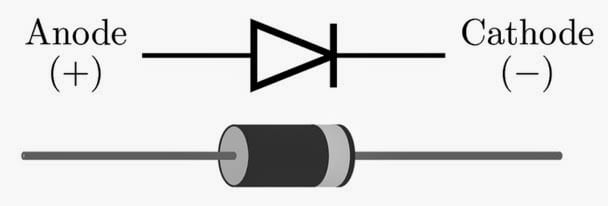DC Solenoids are the worse culprits for electrical surges in your system. When the electrically generated field collapses, an opposite polarity voltage is generated. This voltage spike can be high enough to weld the contacts on a PLC output relay.
To protect your PLC output relay, use a diode to ensure that the voltage spike is released through the diode instead of the relay when the solenoid switches off.
The diode should be rated to handle ten times the voltage you are switching and enough for the current flow of the circuit.
Parts of the diode:
A band marks the cathode of the diode. The electron flow will only occur in one direction.
Installation:
Install the diode as close as possible in parallel with the solenoid. The cathode should be wired to the positive source of the solenoid. (Dissipate negative polarity voltage spike)
Note: You could also install an interposing device to handle the surge, such as an SSR. (Solid State Relay) This is generally more money, space in the panel, and wiring.
Note: Many solenoids already come with surge-suppressing diodes from the manufacturer. If not, you will usually need this information when troubleshooting and discovering your welded contacts of the output relay.
If you have any questions or need further information, please get in touch with me.
Thank you,
Garry
If you’re like most of my readers, you’re committed to learning about technology. Numbering systems used in PLCs are not challenging to learn and understand. We will walk through the numbering systems used in PLCs. This includes Bits, Decimals, Hexadecimal, ASCII, and Floating Points.
To get this free article, subscribe to my free email newsletter.
Use the information to inform other people how numbering systems work. Sign up now.
The ‘Robust Data Logging for Free’ eBook is also available as a free download. The link is included when you subscribe to ACC Automation.



